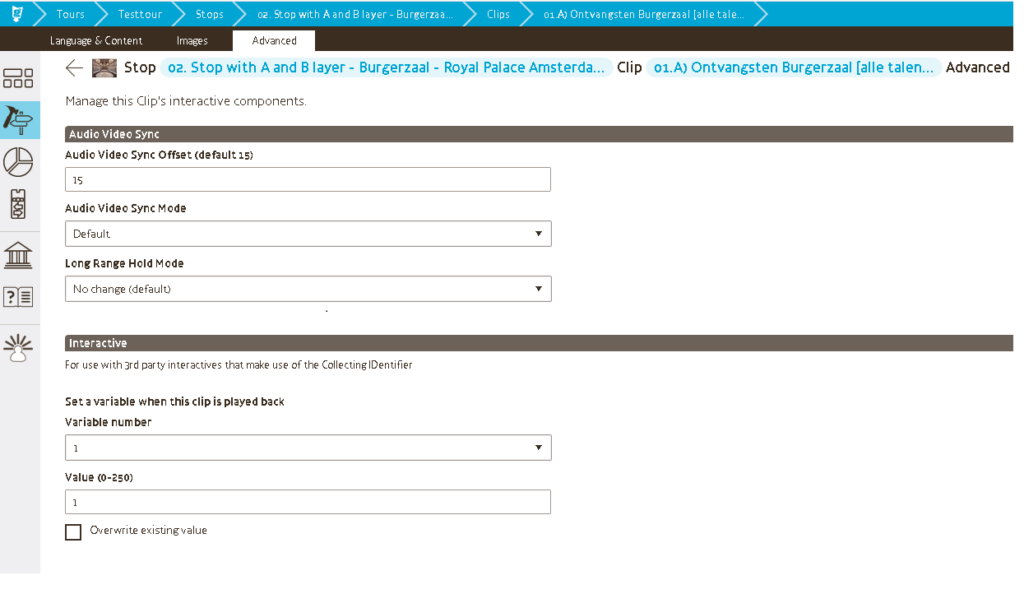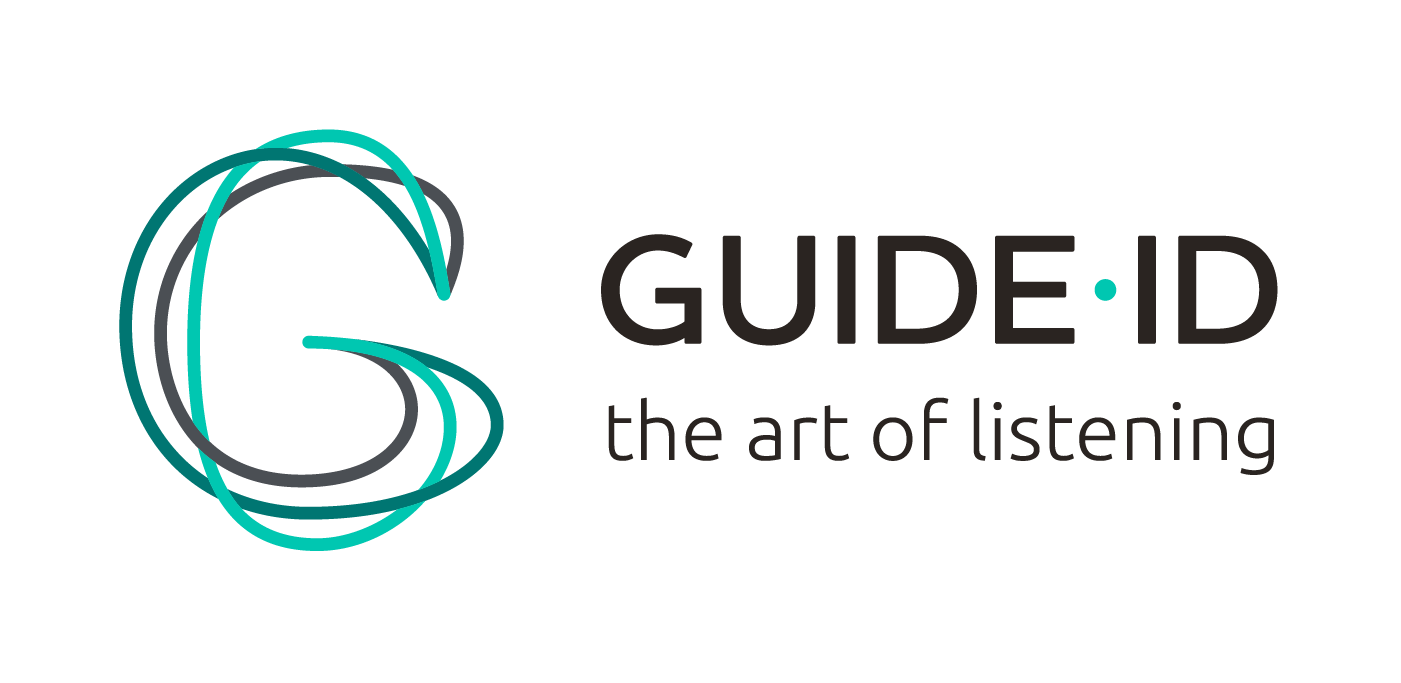previously known as Collecting IDentifier
General
What can you do with the Interactive IDentifier?
The Interactive IDentifier makes it possible to send data from the Podcatcher to an interactive application developed by a third party. Software must be installed on a Windows computer which the application can use to communicate with one or more connected Interactive IDentifiers.
The selected data contains information about the tour, such as a unique tour ID, a unique visitor ID (as in a number, not a person) and the language of the tour. The third party can use this data in an interactive application to identify a visit and/or offer a customized personal experience. For instance, to guide the visitor through an exhibition or to make a connection between multiple interactive applications.
Another example of data which can be tracked could be; responses given by a visitor when questions need to be answered using the A/B/C buttons on the Podcatcher (for instance with a survey). Or tracked data of the usage of layers within an audio stop.
In both cases you add variables and values to the audio clips which can be extracted using the Interactive IDentifier.
Package contents
Interactive IDentifier
This is the point of activation used for visitors to aim the Podcatcher at.
USB cable
The USB cable connects the Interactive IDentifier to the PC on which the interactive application is running.
Installation prerequisites
A PC running Windows 7, 8 or 10.
.NET framework 4 has to be installed.
A free USB port (2.0 or higher)
TourEditor content
If you only want to use the Interactive IDentifier to extract the data from the Podcatcher you do not have to make a stop in the TourEditor.
If you would like to play an audio file on the Podcatchers, after triggering the Interactive IDentifier (for instance; “please follow the instructions on the screen“) you can. You do this by adding a stop in your tour, upload the audio file and add the IDentifier code (trigger) C001. (all Interactive IDentifiers are set to send out code C001 to the Podcatcher).
If you are using multiple Interactive IDentifiers, and you would like a different audio to play at the various points, you make multiple stops in the tour and add a different code to each one of them. For instance C002 / C003 / C004 etc. But beware this also means you need to reprogram the Interactive IDentifier itself to send out the corresponding code.
Reprogramming information will follow soon
Configuration in the TourEditor when adding an audio file to an interactive application
This part of the installation requires access to the Podcatcher Portal.
- Log in to the Podcatcher Portal, click on the TourEditor icon, and choose the Tour you’d like to add the Interactive IDentifier to.
- Make a new Stop (or choose an existing one)
- Go to the Stop’s Clips.
- Edit the first Clip, and upload the audio as appropriate for each language.
- Configure the Stop trigger by adding the Interactive IDentifier code C001 to the Stop. (The IDentifier is standard set to send out code C001 but you can range from C0:01 to C0:7F. You can choose a code and reprogram the Interactive IDentifier.)
- Publish the Tour and start a Sync so the Podcatchers will download the content.
Adding variables and values
- If you want to make use of adding variables and values to track data go to the Stop’s clips and select the clips a visitor can select
- Go to the tab “Advanced” and enter a variable and value at the interactive part.

- A different variable needs to be entered for each clip you want to track when using layers. The value can stay the same.
- If you are asking a question to the visitor where they have to make a choice using the A/B and or C button, you will have to enter the same variable to each clip, but change the values per clip.
- repeat these steps for each clip you would like to track
- Publish the Tour and Sync so the Podcatcher will sync the content on to its SD card.
Installing the Interactive IDentifier
Connect the Interactive IDentifier to a usb port on the Windows PC on which the interactive application will be running.
Install the driver (not necessary for Windows 10)
If you are using Windows 7 or 8, download Driver.zip from http://apps.podcatcher.eu/download/pub/collectingid and extract the .inf file.
Go to Windows Device Manager, select the Collecting IDentifier and set it up to use the .inf file as a driver.
(For Windows 8, Windows first needs to be configured to use unsigned drivers. Follow the instructions on http://www.howtogeek.com/167723/how-to-disable-driver-signature-verification-on-64-bit-windows-8.1-so-that-you-can-install-unsigned-drivers/ to set this up).
Install the Collecting IDentifier Service (required)
Download CollectingIDentifier.1.2.6176.24055.zip from http://apps.podcatcher.eu/download/pub/collectingid
– IMPORTANT: After downloading the .zip file, right-click the file and select Properties. There click ‘Unblock’.
– Extract the contents of the zip file to C:\Program Files\Guide ID\CollectingIDentifier
– Open a command prompt with administrator privileges and go to C:\windows\Microsoft.NET\Framework\v4.0.30319 . From there, enter:
installutil "C:\Program Files\Guide ID\CollectingIDentifier\service.exe"
The service will automatically start when Windows is started. Either restart the computer to start the service, or go to Windows Services, find ‘Collecting IDentifier Service’ and start it manually.
Communicating with the service
You can connect to the Collecting IDentifier Service by opening a TCP socket to localhost on port 777.
You will start to receive JSON messages periodically (heartbeat) or when a Podcatcher is sending data. (The Podcatcher needs to be activated before it communicates with the Interactive IDentifier).
The JSON messages are explained here.
Usage
The visitor can use the Interactive IDentifier by pointing the Podcatcher at the IDentifier, just like any other IDentifier. He or she will hear the audio file which has been uploaded or can follow the instructions on the screen of the interactive application.
Troubleshooting
Should the Interactive IDentifier not work properly, please check the following first:
- Have you activated the Podcatcher with a Start IDentifier?
- Is the USB cable properly connected to the Windows PC on which the interactive application is running?
- Is the Windows PC on which the Interactive application is running switched on? if not restart the PC or contact the third party responsible for the Interactive application.
- Is the interactive application running properly? if not contact the third party responsible for the Interactive application.
- If the Interactive should start an audio file on the Podcatcher, and it doesn’t check the TourEditor
- if the audio files have been uploaded
- if the IDentifier code is connected
- if the content has been published
- Has the Podcatcher been synchronized with the correct content?
If that didn’t solve your problem, unplug the Interactive IDentifier from the USB cable and reconnect it.
